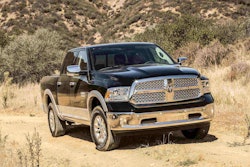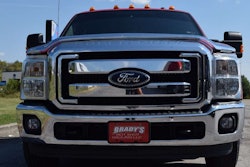For more current hotshot trucking pros and cons, read Overdrive's July 2020 feature on the allure and some drawbacks of hotshot trucking for owner-operators. Find it via this link.
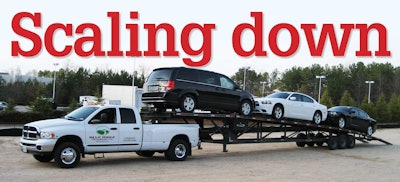 In addition to running cars with the three-car wedge trailer pictured, owner-operator Joey Slaughter also moved RVs for dealers when he started out his independent business as a hotshot.
In addition to running cars with the three-car wedge trailer pictured, owner-operator Joey Slaughter also moved RVs for dealers when he started out his independent business as a hotshot.
In trucking, the term hotshot commonly refers to either the truck or the freight – often both. In the former sense, it’s normally a Class 3-5 truck used in combination with a variety of trailers to run for-hire freight, whether for a single customer or less-than-truckload, though there are exceptions (check out this “hotshot on steroids,” for instance). The truck often will be one of the big three U.S. auto manufacturers’ three-quarter- to one-and-a-half-ton cab-and-chassis rigs or pickups outfitted for weight-distributing gooseneck- or fifth-wheel-type connections to a trailer.
Hotshot freight is hauled for a single customer and needed in expedited fashion. Jeff Ward of the Atlanta area says the local and regional loads he hauls with his one-truck Brady’s Hotshot Hauling are “true hotshot freight.” That freight – often power company equipment to keep the electrical grid running – is needed as soon as possible to avoid a shutdown.
Most agree the hotshot term originated in the Texas oilfields, where decades ago pickups delivered quickly-needed parts to offroad drilling and pumping operations. The niche survives to this day and has benefited from the growth in U.S. fracking operations.
The advantage for all hotshot customers is avoiding service downtime while minimizing costs. Fon Du Lac, Wis.-based hotshot owner-operator Greg Cutler says he can run his gas-fueled 2010 Dodge Ram 2500 at 85 cents per mile, much less than what the average Class 8 operator will spend.
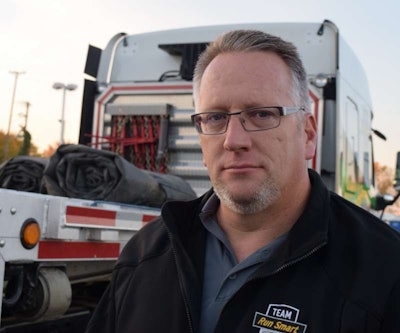 Danville, Va.-based Joey Slaughter
Danville, Va.-based Joey SlaughterJoey Slaughter operated primarily as a car hauler when he started Blue Ridge Transport in 2010 after years as a Class 8 long-haul company driver. Slaughter guesses he ran his own 2005 Ram 3500 at about 80 cents per mile, a good deal lower than his $1.20/mile average thereafter in a car-hauling Class 8 (minus any tractor payment — Slaughter’s currently part of Freightliner’s Team Run Smart group of operators). He transitioned earlier this year from an open car-hauling trailer to a 53-ft. step deck pulled by a Class 8 tractor. He brought in $1.35 a mile in revenue running hotshot, including deadhead, he says.
While Slaughter says he’s doing better than the approximately 55-cents-a-mile hotshot income today, he views the hotshot route as having been ideal for him getting started. A self-described cautious type, Slaughter drove a gas tanker as a company driver for 12 years.
“I wanted to be my own boss,” says Slaughter, who considered hauling cars, “but I was too cautious to go out and buy a large rig and go into a lot of debt.” He bought a 2005 Dodge 3500 dually for $25,000 and found a new $7,000 Kaufman three-car wedge trailer, and he was in business.
“I didn’t realize I’d be on the tightrope,” he says, walking the line between federal regulations and earning income as an independent business.
“I just thought I’d be hauling cars, but the next thing I know, I had to get my DOT number, then the DOT officer’s in my house auditing me as a New Entrant. I’m setting up a drug program, just like a regular trucking company with a Dodge dually and a three-car wedge. I asked [the New Entrant auditor], ‘What’s preventing me from going into business with a full-size tractor-trailer?’ Nothing, he said – just sign up with IFTA, and you’re off to the races.”
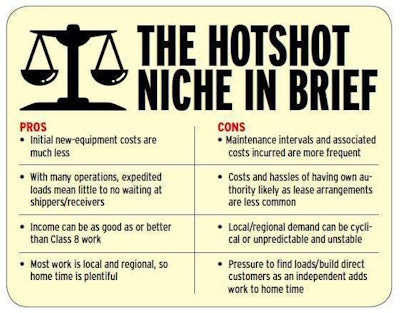 Click through the image for a rundown on key considerations for starting up a hotshot operation. Alternately, follow this link.
Click through the image for a rundown on key considerations for starting up a hotshot operation. Alternately, follow this link.It’s the view from the other direction – seeing hotshot’s low startup equipment costs relative to Class 8 – that drives interest from those driving Class 8 long-haul. Butch Sarma, Getloaded.com product manager, says that every year at the Great American Trucking Show in Dallas, booth visitors show uncommon interest in hotshot oilfield work because of lower equipment costs.
“I could buy a new Ford 250 or 350 and a solid, well-built fifth-wheel or fixed-gooseneck trailer for $75 to $80K. That kind of money with a tractor-trailer will not get you a new model.” Furthermore, a new Class 3 rig with a new trailer, says Sarma, “will have maintenance costs lower than those of an 18-wheeler that’s five years old.”
The spotlights on the businesses that follow highlight how hotshot has worked for three owner-operator businesses. Click through the images for more on their operations.
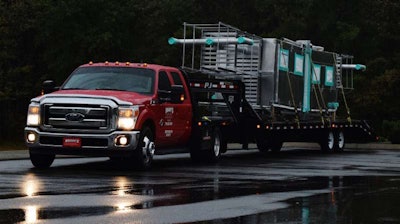 GEOGRAPHIC SPECIALIZATION: Brady’s Hotshot Hauling owner-operator Jeff Ward runs a mix of shipper-direct hotshot loads and brokered freight, like these lightweight aluminum railroad signal houses, from an Atlanta-area home base.
GEOGRAPHIC SPECIALIZATION: Brady’s Hotshot Hauling owner-operator Jeff Ward runs a mix of shipper-direct hotshot loads and brokered freight, like these lightweight aluminum railroad signal houses, from an Atlanta-area home base.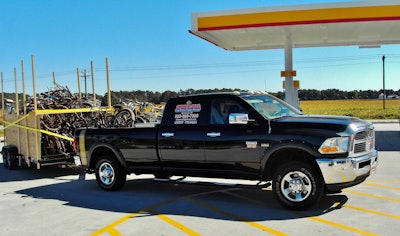 CAR/MOBILE EQUIPMENT HAULING: Owner-operator Greg Cutler, based in Wisconsin, specializes in mobile equipment with a bumper-pull set-up. The above October haul he ran for a friend in South Carolina to Wisconsin. It featured a different kind of towed vehicle. Taking farm equipment on the long run down, Cutler fashioned a side kit from plywood and lumber and hauled these bicycles in two trips back.
CAR/MOBILE EQUIPMENT HAULING: Owner-operator Greg Cutler, based in Wisconsin, specializes in mobile equipment with a bumper-pull set-up. The above October haul he ran for a friend in South Carolina to Wisconsin. It featured a different kind of towed vehicle. Taking farm equipment on the long run down, Cutler fashioned a side kit from plywood and lumber and hauled these bicycles in two trips back.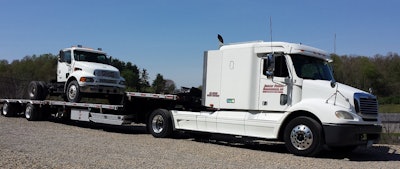 ‘HOTSHOT ON STEROIDS’: That’s what Sue Nelson of Ohio-based Straight Forward Transportation calls this single-drive-axle Freightliner, driven primarily by her husband, Kevin. It’s complemented by a Ford F250 diesel in which Sue occasionally runs a load in addition to handling all the back-office functions for the couple’s small fleet.
‘HOTSHOT ON STEROIDS’: That’s what Sue Nelson of Ohio-based Straight Forward Transportation calls this single-drive-axle Freightliner, driven primarily by her husband, Kevin. It’s complemented by a Ford F250 diesel in which Sue occasionally runs a load in addition to handling all the back-office functions for the couple’s small fleet.


